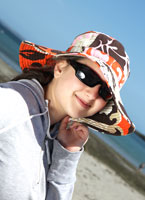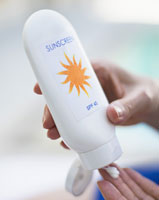Section navigation
How to protect yourself from the sun

Staying safe from the sun and UV radiation is easy if you follow the steps below every day!
- Avoid sunburns. Five or more sunburns double your risk of developing skin cancer.
- Avoid sun tanning and tanning beds. UV light from tanning beds and the sun cause skin cancer and make your skin look wrinkled. If you want to look like you’ve been in the sun, think about using a self-tanning lotion. Remember that you still need to use sunscreen, even if you use a self-tanning lotion!
- Apply lots of sunscreen. Use sunscreen on all exposed skin. Your sunscreen should have a sun protection factor (SPF) of at least 15. Your sunscreen should protect you from both ultraviolet A (UVA) and ultraviolet B (UVB) rays. Reapply every two hours, even on cloudy days, and after swimming or sweating. Do not forget to apply sunscreen to your lips, ears, feet, hands, bald spots or a part in your hair, and the back of the neck. Also, apply it under bathing suit straps, necklaces, bracelets, and sunglasses. You should put on one ounce of sunscreen every two hours — one ounce is about the size of a ping pong ball. Use more if you are swimming or sweating. A small tube containing three to five ounces of sunscreen might only be enough for one person during a day at the beach.
- Wear protective clothing. Put on a long-sleeved shirt, pants, a wide-brimmed hat, and sunglasses when possible.
- Wear sunglasses. Wearing sunglasses protects your eyes from harmful UV rays when outdoors. Choose sunglasses with 99 to 100 percent UVA and UVB protection, to block both forms of ultraviolet rays.
- Sit in the shade. Remember that the sun’s UV rays are strongest between 10 a.m. and 4 p.m. Try to stay in the shade if you are outside during these times.
- Be careful near water, snow, and sand. Water, snow, and sand can reflect the damaging rays of the sun and increase your chance of sunburn.
- Watch the UV Index.The UV Index provides important information that can help you plan your outdoor activities to avoid getting too much of the sun’s rays. You can learn more about the UV Index in the Sun section of girlshealth.gov. Also, you can check the UV Index on most weather websites or at the Environmental Protection Agency.
- Get Vitamin D safely. Vitamin D is an important vitamin that our bodies make when we are out in the sun. But there are other ways to get vitamin D without being in the sun. You can get vitamin D through fortified milk and orange juice, cheese, butter, cereals, and fish. You can also get vitamin D through vitamin supplements. Talk to your doctor or nurse if you have questions about vitamin D.
- Avoid tanning oils. They do not protect you from the sun, and may increase the chances that you will get a sunburn.
- Tanning does not ‘protect’ your skin from sunburn. You may have heard that building up a ‘base tan’ before going to the beach will protect you from sunburn. But this is not true! A tan is a sign of damaged skin. It does not protect you from getting a sunburn.
What is SPF?
 So what is the sun protection factor (SPF), anyway? You probably hear about it all the time, but never gave much thought to what it means. The SPF tells the relative amount of sun protection that a sunscreen will give you when used the right way. Sunscreens protect your skin by absorbing and/or reflecting UVA and UVB rays.
So what is the sun protection factor (SPF), anyway? You probably hear about it all the time, but never gave much thought to what it means. The SPF tells the relative amount of sun protection that a sunscreen will give you when used the right way. Sunscreens protect your skin by absorbing and/or reflecting UVA and UVB rays.
All sunscreens in the United States must have an SPF label. Sunscreens with an SPF of at least 15 are recommended. You should know that an SPF of 30 is not two times more protective than an SPF of 15. Instead, when used the right way, an SPF of 15 protects the skin from 93 percent of UVB radiation and an SPF of 30 protects you from 97 percent of UVB rays.
Although the SPF rating on sunscreen is for UVB rays only, many kinds of sunscreens also include ingredients that protect from UVA rays as well. These are called “broad-spectrum” sunscreens and they are highly recommended! Check your sunscreen to see if it is broad-spectrum.
How can I get tan without the sun?
Sunless tanners and bronzers can give you a temporary tan without the sun. Sometimes different areas of the skin can color unevenly. Remember to always wash your hands after applying tanning lotion! The lotion can stain your hands.
Content last reviewed July 20, 2010
Page last updated October 31, 2013







